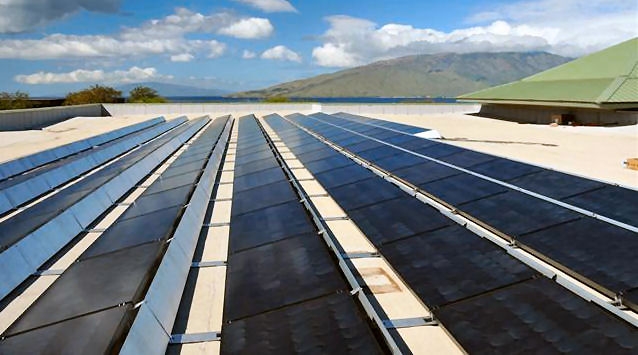Hawaiian Electric Companies Propose Continued Growth of Rooftop Solar
By Maui Now Staff
The Hawaiian Electric Companies provided recommendations to the Hawai‘i Public Utilities Commission this week that proposed new customer options and programs to support continued growth of rooftop photovoltaic systems in Hawai‘i.
Company representatives say these changes would help grow Hawaiʻi’s local energy industries and economy, protect the environment, and lower the cost of energy for Hawai‘i residents and businesses.
“We know how much our customers want the benefits of rooftop solar,” said Jim Alberts, Hawaiian Electric senior vice president of customer service in a company press release announcement. “We support and expect continued growth of rooftop solar. With levels of solar energy in Hawai‘i that are twenty times higher than the nationwide average, these proposals provide greater access to rooftop PV while helping ensure the longevity of programs in a way that protects reliability, safety and fairness for all customers.”
Under Hawaiian Electric’s proposal, customers with a Net Energy Metering agreement and those with valid pending applications will continue under the present program. Hawaiian Electric proposes that any changes would apply only to new PV systems, and only after the PUC makes its final determination on the program.
Alberts estimates that the plan will help Hawaiian Electric to triple the amount of distributed rooftop PV by 2030, and increase renewable energy to 65% by 2030 and 100% by 2045.
Hawaiian Electric provided a list of the proposed recommendations, which include the following:
- A new pricing structure for new rooftop PV systems that more fairly shares costs for operating and maintaining the electric grid. Currently, customers with rooftop PV are annually shifting about $53 million in grid operations and maintenance costs to customers who do not have rooftop PV.
- Nation-leading technical standards for advanced inverters, which will improve integration of high levels of rooftop PV.
- New options for customers, including battery-equipped rooftop photovoltaic systems.
- A pilot time-of-use rate to offer customers the opportunity to save money by shifting their energy use to different times of day, particularly when PV panels are most productive.
- An improved method of calculating the amount of rooftop PV that can be safely installed without impacting service reliability for other customers.
- Streamlined and standardized PV application processes to improve efficiency and provide further transparency of the status of applications.
In an effort for rooftop PV customers owners to share more fairly in costs for operating and maintaining the electric grid, the company prposes
- Crediting at a rate of 18 cents per kilowatt-hour for all solar energy sent to the grid from future rooftop PV systems by O‘ahu customers. This represents a premium over the utility cost of producing energy on O‘ahu, which, based on current fuel and purchased power costs, is approximately 12 cents per kWh. (The rate for Hawai‘i Island would be 22.5 cents per kWh and the rate for Maui would be 23.1 cents per kWh, based on the utility cost of energy for those islands).
- A minimum monthly bill of $25 for future residential PV systems on all islands. Currently, residential customers have a minimum bill of $17 on O‘ahu, $18 on Maui, and $20.50 on Hawaiʻi Island.
Company representatives say these changes will reduce the shifting of grid operations and maintenance costs from solar to non-solar customers that occurs under the current program while still offering new PV system owners a significant benefit from their investment.
“These changes will help reduce the unfair shifting of costs from those with PV to those who don’t have PV. Contrary to what some may think, these changes won’t increase our profits,” Alberts said. “We’re working to ensure fair rates for all of our customers while still preserving the opportunities to integrate more renewable energy for Hawai‘i.”











